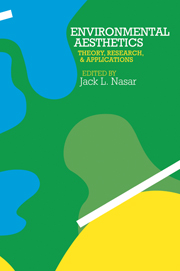Book contents
- Frontmatter
- Contents
- List of figures
- List of tables
- List of contributors and participants
- Acknowledgments
- Preface
- Section I Theory
- Section II Empirical studies
- Editor's introduction
- A Methodological comments
- Editor's introduction
- 9 The assessment of landscape quality: an integrative approach
- 10 Affective appraisals of environments
- B Architectural interiors
- C Architectural exteriors
- D Urban scenes
- E Natural and rural scenes
- Section III Applications
- References
- Index of authors
- Subject index
Editor's introduction
Published online by Cambridge University Press: 05 September 2013
- Frontmatter
- Contents
- List of figures
- List of tables
- List of contributors and participants
- Acknowledgments
- Preface
- Section I Theory
- Section II Empirical studies
- Editor's introduction
- A Methodological comments
- Editor's introduction
- 9 The assessment of landscape quality: an integrative approach
- 10 Affective appraisals of environments
- B Architectural interiors
- C Architectural exteriors
- D Urban scenes
- E Natural and rural scenes
- Section III Applications
- References
- Index of authors
- Subject index
Summary
In attempting to quantify emotional responses to visual attributes of the environment, investigators have employed a variety of methods. Studies vary in choice of subjects, scenes, modes of presentation, measures of environmental attributes, measures of affect, and analytic procedures. For purposes of application, ecological validity is desirable: The conditions of the study should approximate as closely as possible the real conditions to which the results are to apply. This inplies the use of a diverse or representative sample of respondents, and a diverse or representative sample of scene stimuli. In addition, the features of the environment and the kinds of responses obtained should be relevant to naturalistic experience.
Fenton and Reser focus on methodological choices. Three approaches to environmental assessment – objective, subjective, and phenomenological – are reviewed. The authors argue for an integrative approach, in which salient attributes of scenes are first derived and assessed, evaluative responses are then obtained, and the relationship between evaluation and the salient features are examined. Several studies (Flynn; Oostendorp and Berlyne; Nasar; Fenton) in this collection employ strategies similar to those proposed here.
Russell describes the results of a series of studies that derived dimensions of environmental affect. This paper is presented in this section rather than elsewhere because rather than focusing on one kind of setting, it examines a diverse array of molar environments (including interiors, urban scenes, and natural scenes).
- Type
- Chapter
- Information
- Environmental AestheticsTheory, Research, and Application, pp. 107Publisher: Cambridge University PressPrint publication year: 1988

